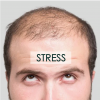 The relationship between stress and the hair cycle
The relationship between stress and the hair cycleThere are about 100,000 hair follicles on the adult scalp (although this number can vary based on hair color). Every hair follicle is constantly cycling between growth and rest. Most of these hair follicles are in the growth phase (anagen) at some point. When the hair follicle transitions to telogen or the resting phase, the hair falls off. During an episode of telogen effluvium, a trigger causes a sudden, abnormal shift of hairs in the telogen phase all at once. A possible trigger for this sudden shift? Significant emotional stress. What qualifies as significant emotional stress? Think of major, negative life events (i.e., loss of a loved one or divorce). While a single bad day at work should not meet this threshold, severe and prolonged stress from, for example, the Covid-19 pandemic could certainly qualify. To test the relationship between substantial stress and hair loss, researchers artificially exposed mice to noise stress (a form of psychosocial stress) and found that this caused an early termination of anagen, or the growth phase of the hair cycle. This study confirmed the idea that stress disrupts the normal cycle of hair follicles and can lead to hair loss. The signs of telogen effluvium
Hair loss associated with telogen effluvium is abrupt, diffuse and temporary.
Abrupt start
Telogen effluvium is characterized by the abrupt onset of hair loss - but there is a catch. Hair loss usually does not start until about three months after the triggering event. Why? Once the hair follicles enter the telogen phase prematurely, it takes about three months for the cycle to complete and the hair to fall out. Stress is one of the many triggers of telogen effluvium; medications, severe illness, and childbirth can also trigger an episode.
Diffuse dilution
The pattern of hair loss associated with telogen effluvium is diffuse. Partial hair loss or widening of the parting line is generally suggestive of other diagnoses, such as alopecia areata or female hair loss. Individuals experiencing telogen effluvium may notice a thinner ponytail, or a sudden increase in fallen hair in the shower, on the pillowcase, or around the house. It's considered normal to shed about 100-200 hairs per day (check out this hair loss scale to get an idea of what 200 hair loss looks like), but the exact number varies based on the individual or hair care practices. While it is not uncommon for up to 50% of scalp hair to be shed during a telogen effluvium, reassuringly, this condition does not cause complete baldness.
Temporary in nature
The other good news? The hair loss is temporary and should return to pre-effluvium density, although this process is generally slow. It can take months (but generally less than 6) for shedding to stop, then months to years for lost hair to grow back at a slow rate of ~½ inch per month. In some circumstances, the hair does not fully return to its normal density. First, telogen effluvium can reveal other types of long-term hair loss (such as female pattern). In addition, overall hair density is expected to decrease slowly with age, and in a few (usually women aged 30-60 years), telogen effluvium can be chronic and persist for several years.